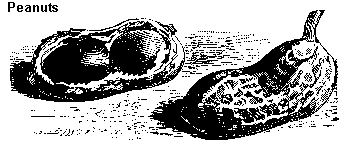Plant seeds are the mainstays of the diets of most of the
world’s population. And most of us consume seeds in one form or another every day.
Let’s look at one example: corn. Sources of corn in our diets include fresh corn,
corn meal (corn bread or tortillas), corn oil, cornstarch, and corn syrup. Why are seeds such an important source of nutrients? When we
consume seeds, we are consuming the food that the plant stored in its seed to nourish the
tiny embryo. Plants invest a lot of energy in flowering and forming seeds, so it makes
sense that they would also provide a concentrated, high quality source of nutrients to the
germinating seed and growing embryo.
Cereals. Almost three quarters of all the crops
grown in the world are members of the grass family. Grasses are grown as forage crops for
domesticated animals like cows and sheep; they are also a vital food source for humans.
The name cereals describes grasses that form
fruits—grains—that humans consume directly (as opposed to feeding them to
livestock). Examples of cereals are wheat, corn, and oats. A grain (the botanical term is
caryopsis) is a fruit in which the dry ovary wall is fused with a single seed and its
seedcoats.
Why are cereals such an important source of food for
people all over the world? Cereals provide a concentrated source of carbohydrates, along
with some proteins and oils. They are easily handled, transported, and
stored—important characteristics, especially in regions of the world where harvested
crops must be stored for use during the cold winter months.
In their natural, unrefined state, grains contain lots of
fiber. Remember that cellulose is the primary component of fiber. The bran, or outer layer
of the grain, contains cells with thick, cellulose-rich cell walls. Unrefined grains also
contain proteins and oils. Most of these are contained in the germ, which is the
embryo and the single cotyledon. (Remember, grasses are monocots, meaning they have one
cotyledon.) During refining, the bran and germ are removed. Refined grains, and products
made from them, are primarily a source of carbohydrates in the form of starch, and contain
relatively little protein or fiber. Examples of refined grain products include white
flour, most pasta, and white rice.
The major cereal crops are maize or corn (in the New World
temperate and subtropical regions), wheat (in western Asia and Europe in regions with
temperate to cool climates and moderate rainfall), and rice (in the tropics). Other cereal
crops are barley, rye, sorghum, millet, and oats. It is interesting to note that rice is
the primary food source for more than half the world’s people.

Other, non-cereal seeds are sometimes used in the same
ways as true cereals—ground into flour or used in baking, for example. These include
buckwheat, quinoa, and amaranth.
Legumes. Humans consume both the fruits
and seeds of legumes in their fresh state, and also eat the seeds fresh or dry them. If
you eat a green bean, you are eating both the fruit (the pod) and the seed (inside the
pod). Compared to cereals, legumes have a much higher protein content, often containing
25% or more protein.
One species of legume, Phaseolus vulgaris, accounts
for many of the beans familiar to cooks and gardeners. Different types of P. vulgaris
include: kidney, field, garden, haricot, pinto, great northern, and yellow-eye beans, to
name a few. And don’t forget the green, string, snap, and wax beans we nibble right
in the garden. These are also types of P. vulgaris that we’re harvesting and
eating while the pod, or fruit, is still in its immature stage.
Other types of legumes (species other than P. vulgaris)
are lima, scarlet runner, shell, black, pea, black-eyed, and kidney beans. Peas (Pisum
sativum) are also legumes, as are include chick peas, cowpeas, black-eyed peas, lentils,
soybeans. And, of course, peanuts are a very popular legume, rich in proteins and oils
(30% proteins, 48% oils, 12% carbohydrate).

Like the cereals, legumes are easily handled, dried, and
stored. However, an even more important feature is the ability of leguminous plants to fix
atmospheric nitrogen. Many types of legumes have a certain type of bacteria living in
nodules in their roots. These bacteria are able to take in atmospheric nitrogen and
convert it into a form useful to the plant. Remember, nitrogen is a critical component of
amino acids, and therefore proteins.)
Not only do the edible parts of legumes contain
significant protein, but the plants also don’t need expensive nitrogen fertilization.
And when crop residues are tilled in, they add nitrogen to the soil so that it is
available for future crops.
Nuts. Though many foods we commonly refer
to as nuts are not in the true nuts, we’ll group them together here for convenience.
A true nut, botanically speaking, is a dry, one-seeded fruit. Nuts are indehiscent,
meaning the seeds remain in the fruit after the fruit is shed from the parent plant.
Examples of true nuts include acorns and hazelnuts (filberts).
Almonds and walnuts are technically the seeds
of fleshy, one-seeded fruits (drupes), and are thus not true nuts. Almonds come from a
peach-like fruit. In peaches, we eat the sweet flesh and discard the "pit;" in
almonds, we discard the fibrous flesh and keep the pit. The edible portion of the almond
is contained within a hard hull. Walnuts are also contained within a very sturdy hull.
Though they dry and store fairly well, nuts are not a
significant source of food for most of the population, in part because they are difficult
to harvest mechanically. Nuts are concentrated sources of oil, and have proportionally
fewer carbohydrates than cereals or legumes.
